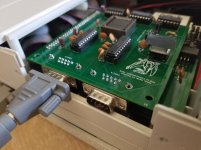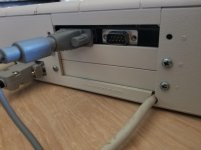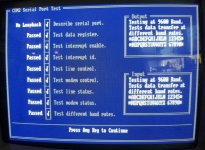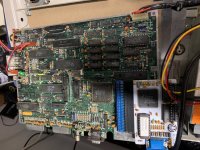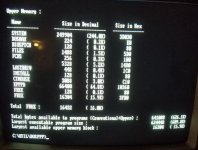Eudimorphodon
Veteran Member
Per some overloading in some other threads, one of the projects I've been working on for my Tandy 1000 EX is a native serial card based on the 16552 dual UART, which is essentially two 16550 enhanced FIFO-equipped UARTs joined at the hip. I received my prototype PCB boards and some UARTs nearly two weeks ago, but the 75185 transceivers that in retrospect were probably stupid of me to have ordered from eBay took *forever* to get through the mail, so I was just able get down to soldering one together last night.
The starting basis of the schematic for this board is the serial portion of Sergey's combo FDC and serial port board that uses a single 16550. I wasn't able to find (I'm sure it's out there) a design using the 16552, so I adopted the circuit based on the datasheet; the 16552 seems to be specifically optimized for use in PC applications so most of the work involved making a new KiCad library symbol for the part. A 7408 AND gate is used to combine the "second channel" and "chip select" signals for COM2, but otherwise the decoding hardware is essentially the same. I removed the IRQ jumpers and just hardwired IRQ4 to the first channel and IRQ3 to the second (This seems reasonable to me for a Tandy 1000 with no built in devices using those IRQs and *probably* only one serial card), but there are jumpers to select between COM1/3 and 2/4 for the two channels respectively.
Anyway, here's the board with all the sockets soldered but chips not populated:
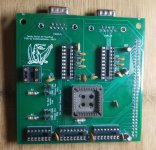
Here it is installed with my homebrew RAM/ROM/Calendar and IDE header boards:
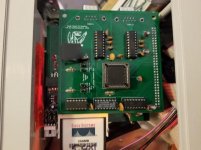
This picture shows a slight issue; in order to save money on the prototype run I limited the board size to 100x100 mm. (Going over that bumps the price up by about a factor of ten.) Because of this the serial ports are recessed slightly from the back of the machine. I don't think in practice this will be a big problem. I did include some holes in the board for interfacing with some kind of mounting hardware, I'm going to talk to a friend who's a 3D printing guru and see if it might be possible to 3D print a mount that can make the recessed ports look "right" while stabilizing the board for plug insert/removals, etc.
Check-It! identified two serial ports as being present after the initial power on:

So I downloaded CuteMouse 2.1b4, attached one of the new-old-stock mice:

I scrounged up (I have 8 of them so I figured one would do do as a smoke test), and tried loading the driver:
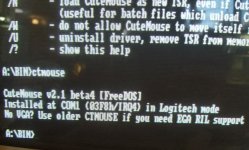
And... at least so far as driving a mouse goes, the card seems to work. It passes Checkit3's input device test:

Works in Qbasic, Edit, and Hoyle's Book of Games:

And everything also still works when I switch the mouse to COM2 instead of COM1.
I'm going to try to scrape up the bits I need to do a null-modem test later, but working with a mouse is at least a promising sign.
As an aside, I'm impressed with the Cutemouse driver; it automatically checks to see if there is available UMB space to load itself into (you don't have to "loadhigh" from autoexec.bat), and it's working with the UMB manager I have driving the upper memory blocks provided by my custom RAM card. I still have over 609k of lower DOS memory after the mouse driver loads. (And it takes less than 4k from the UMB pool, so I still have nearly 80k free there.) I need to see if I can get some of the XT-compatible paint programs I used to while away countless hours on back in the 80's working on this system in full 16 color Tandy Graphics glory.
The starting basis of the schematic for this board is the serial portion of Sergey's combo FDC and serial port board that uses a single 16550. I wasn't able to find (I'm sure it's out there) a design using the 16552, so I adopted the circuit based on the datasheet; the 16552 seems to be specifically optimized for use in PC applications so most of the work involved making a new KiCad library symbol for the part. A 7408 AND gate is used to combine the "second channel" and "chip select" signals for COM2, but otherwise the decoding hardware is essentially the same. I removed the IRQ jumpers and just hardwired IRQ4 to the first channel and IRQ3 to the second (This seems reasonable to me for a Tandy 1000 with no built in devices using those IRQs and *probably* only one serial card), but there are jumpers to select between COM1/3 and 2/4 for the two channels respectively.
Anyway, here's the board with all the sockets soldered but chips not populated:

Here it is installed with my homebrew RAM/ROM/Calendar and IDE header boards:

This picture shows a slight issue; in order to save money on the prototype run I limited the board size to 100x100 mm. (Going over that bumps the price up by about a factor of ten.) Because of this the serial ports are recessed slightly from the back of the machine. I don't think in practice this will be a big problem. I did include some holes in the board for interfacing with some kind of mounting hardware, I'm going to talk to a friend who's a 3D printing guru and see if it might be possible to 3D print a mount that can make the recessed ports look "right" while stabilizing the board for plug insert/removals, etc.
Check-It! identified two serial ports as being present after the initial power on:

So I downloaded CuteMouse 2.1b4, attached one of the new-old-stock mice:

I scrounged up (I have 8 of them so I figured one would do do as a smoke test), and tried loading the driver:

And... at least so far as driving a mouse goes, the card seems to work. It passes Checkit3's input device test:

Works in Qbasic, Edit, and Hoyle's Book of Games:

And everything also still works when I switch the mouse to COM2 instead of COM1.
I'm going to try to scrape up the bits I need to do a null-modem test later, but working with a mouse is at least a promising sign.
As an aside, I'm impressed with the Cutemouse driver; it automatically checks to see if there is available UMB space to load itself into (you don't have to "loadhigh" from autoexec.bat), and it's working with the UMB manager I have driving the upper memory blocks provided by my custom RAM card. I still have over 609k of lower DOS memory after the mouse driver loads. (And it takes less than 4k from the UMB pool, so I still have nearly 80k free there.) I need to see if I can get some of the XT-compatible paint programs I used to while away countless hours on back in the 80's working on this system in full 16 color Tandy Graphics glory.

